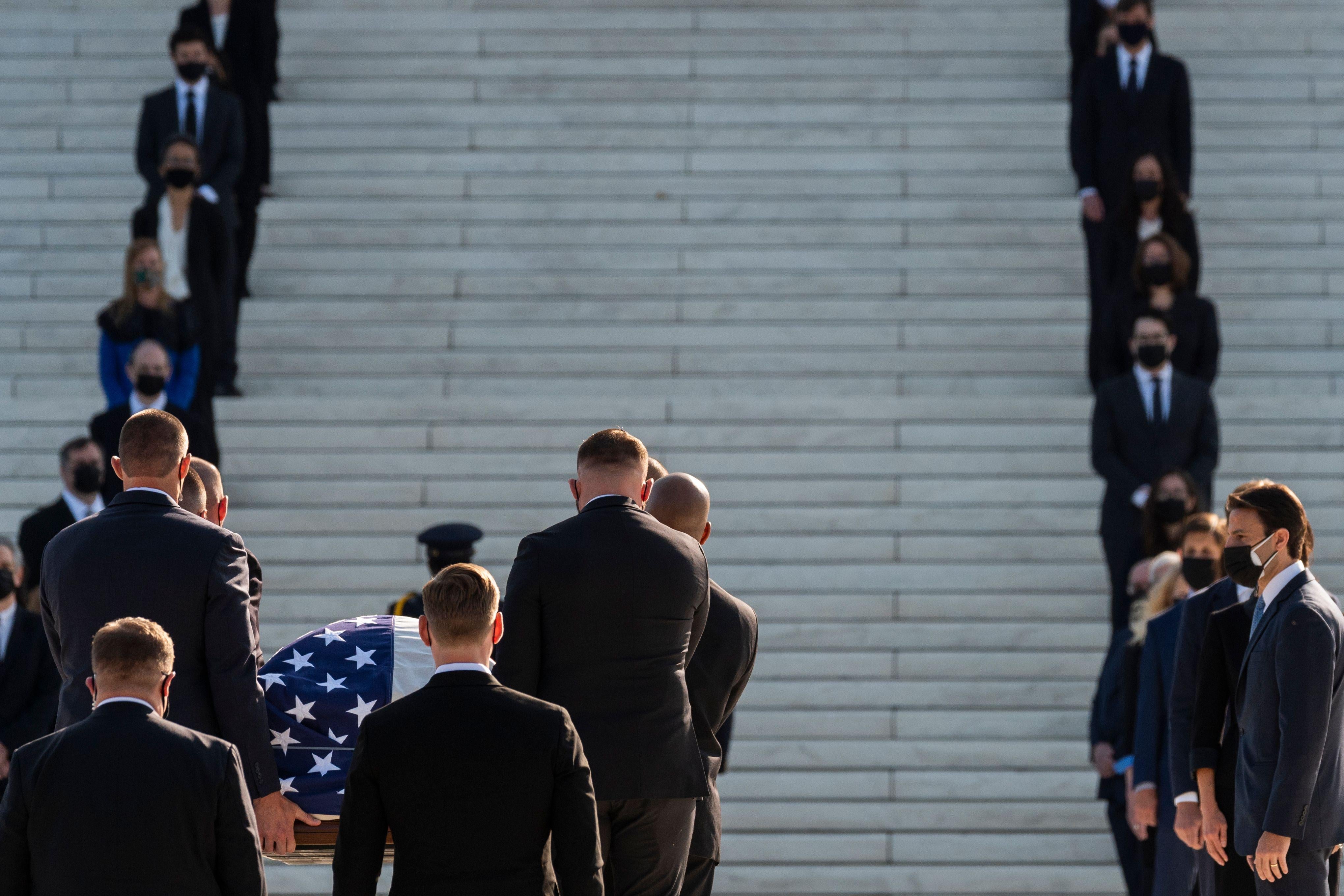Over 48 hours, 120 former and current law clerks to Ruth Bader Ginsburg stood on the courthouse steps over her casket, as she lay in repose at the U.S. Supreme Court. Nicknamed “RBG’s Army” in the press, they took 20-minute shifts for a day-and-night vigil. We asked a few of them to share their experience of holding the vigil:
Gillian Metzger (clerked: 1997–98)
I loved that they called us RBG’s Army, because that’s what it felt like. Across the plaza, there we all were, fiercely loyal and determined to serve the justice one last time. For the next 48 hours, she was never without two clerks at her side. My first shift was in the evening and it was extraordinary, standing on the Supreme Court steps with the Capitol lit up and someone singing “Amazing Grace” in the background, and hundreds of people—old, young; families with kids, singles, couples—walking by to honor her. I think we were all both very sad and simultaneously invigorated to keep fighting the battles she will no longer be around to fight.
Amanda Tyler (clerked: 1999–2000)
Being together with the RBG clerk family these last few days was deeply comforting. To be around others who hold the same profound respect, admiration, and love for her made the loss just a little less devastating. And it was a beautiful ceremony for which so many of us traveled despite the pandemic, which shows just how much we all loved her.
The clerks signed up two clerks at a time to stand vigil in 20 minute shifts. The idea, of course, was to keep the clerk guard as safe as possible in light of COVID. For the vigil, we stood outside with her during the day so that the public could pay their respects, and then we came inside every night at 11 p.m. to stand vigil overnight until the next morning. The middle of the night shifts were really moving and yet also intense and emotionally very hard. This is because inside, it was just two clerks and one Honor Guard with her in the vast Great Hall. I was on the last vigil shift before we turned her over to the family and she left the court for the final time. That was a very difficult assignment only outdone by watching her leave the court soon thereafter, a sight that frankly broke my heart.
Phil Weiser (clerked: 1995–96)
My time at the vigil was one of great reflection—on how Justice Ginsburg moved our nation toward a more perfect union, on how she shaped me personally and professionally, and on where we go from here. During this scary time, I am comforted that she never lost her cool, she kept her steadfast belief that justice would prevail in the end, and she kept fighting—until the end of her life—for what is right. I both cannot believe that she is gone and am utterly convinced that her memory will be a blessing.
David Franklin (clerked: 1999–2000)
I was in the Array of Many Black-Clad Clerks but didn’t get a chance to stand vigil over her casket afterward. That might have been differently powerful. Standing on the plaza with all of the other clerks, though, was an ambivalent experience for me. On the one hand, I knew it was a powerful image that sent the message that many people are still standing up for what the justice believed. On the other hand, I’ve never liked being lined up for any purpose, and part of me felt resentful at being conscripted into a stately, regimented display on the plaza of a court that risks being converted into a site of raw power for a party of chaos and cruelty.
Margo Schlanger (clerked: 1993–95)
Justice Ginsburg was a judge for over 40 years—13 on the D.C. Circuit and 27 on the Supreme Court. So when the justice’s law clerk family gathered at the Supreme Court on Wednesday, we ranged in age from mid-20s to over 70. While there are other more important progeny—most especially her litigation successes and her Supreme Court opinions—her 140+ law clerks are part of her legacy too. It was a stunning privilege to stand with 40 years of lawyers, and display our respect and sorrow.

Neil Siegel (clerked: 2003–04)
It was an extraordinarily hard few days in an extraordinarily hard couple of years, even as I realize how privileged I am. Grief is still grief, and a broken heart is a broken heart. I saw well more than 100 of Justice Ginsburg’s law clerks come together to honor her and express their love for her.
She was always there for my daughters and me. I am grateful that I was able to be there for her. Those several minutes next to her casket, with the president behind me, I will take to my grave.
